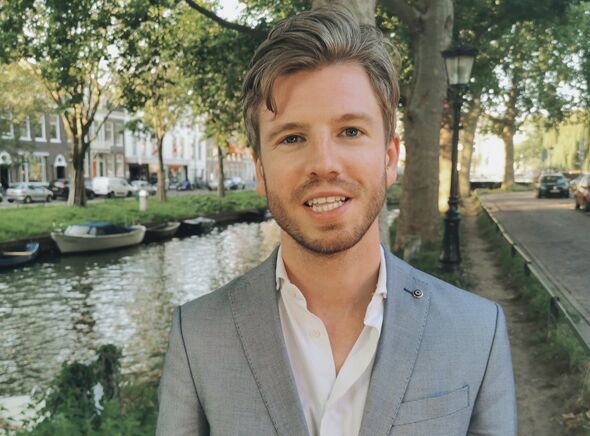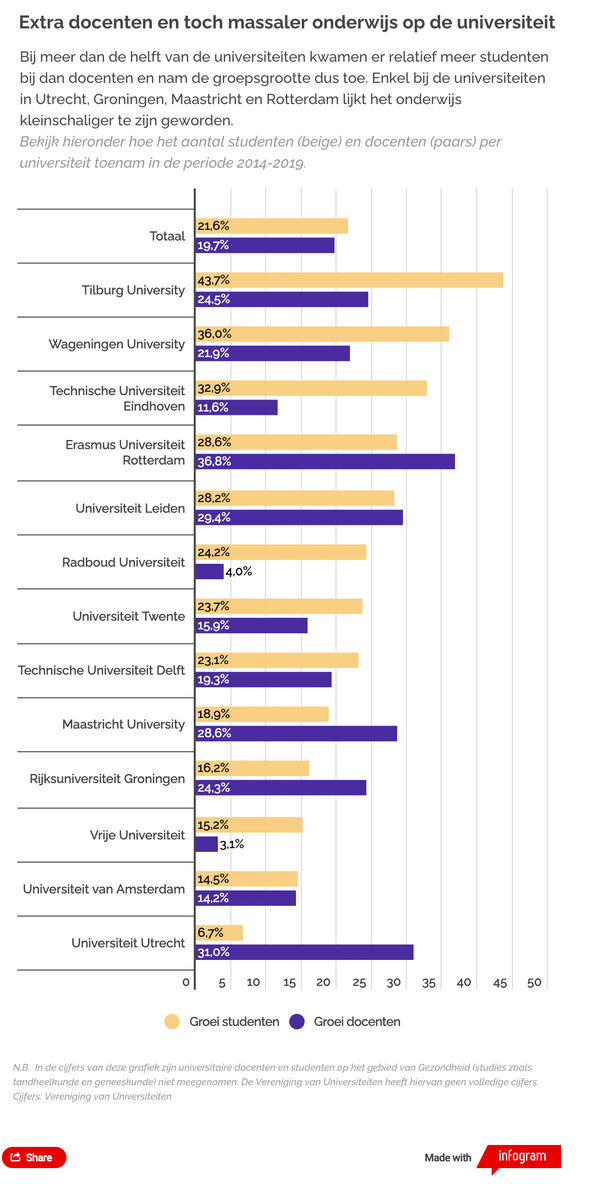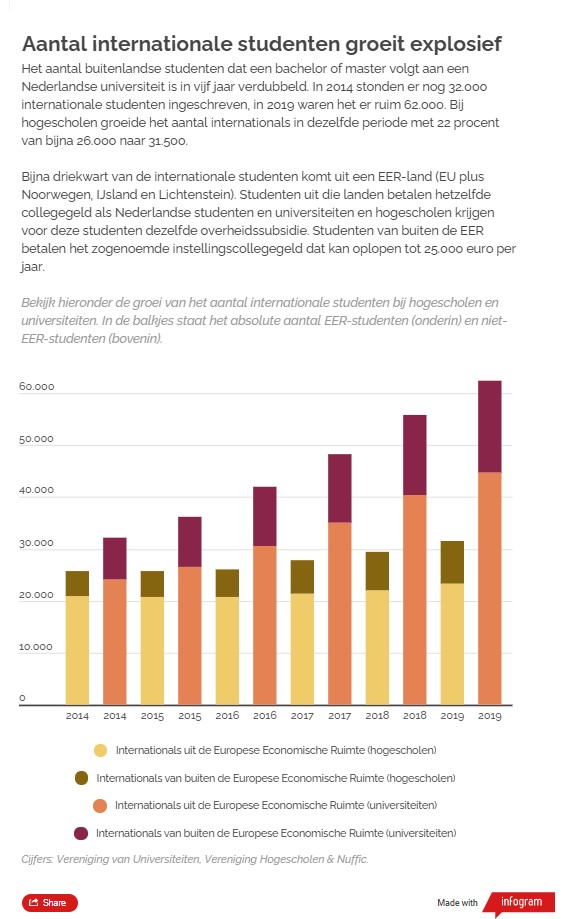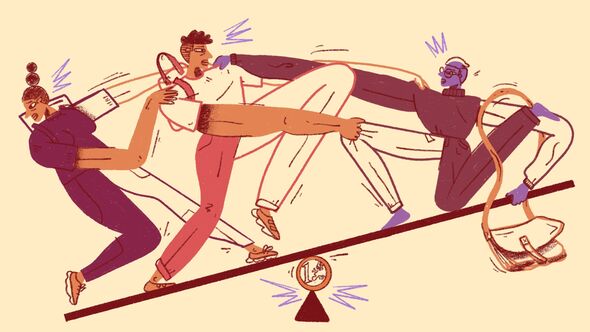
The growth of the international influx erodes the education budget
Funds are being scattered
Students who lost their basic grant would get better education in return. Fewer massive lectures, more small working groups. But the hundreds of millions of euros that are freed up thanks to the cutback of the basic grant, are a drop in the ocean because of the unbridled increase in the number of international students.
In this third part of a series of investigative stories, we find out why students notice so little of the extra teachers that came with the introduction of the loan system.
- The 4,000 lecturers Minister Bussemaker promised students when she cut the basic grant in 2015 have arrived.
- Higher education is growing rapidly: since the abolition of the basic grant, the number of students increased with more than 67,000.
- This growth spurt is largely accounted for by universities, where the number of students has increased by 22 percent.
- There are no limits to the student growth, now that competition has shifted to the global market.
- As a result, the education budget is being increasingly eroded.
To stay ahead of the competition, the University of Amsterdam accelerated the start of the new interdisciplinary programme Politics, Psychology, Law & Economics (PPLE) in 2014. In May of that year, four hundred applications had already been received, while the accreditation had not even been finalised and the student council had yet to approve the start of the English-language bachelor's programme for 'ambitious and intellectually talented students'.
"As a student council, we were ambivalent about that project," says Stefan Wirken, who became president of the Dutch Student Union (LSVb) in 2015. Before that, he had been a member of the student council of the law faculty with final responsibility for PPLE for two years. "It was a lot like a prestige project, an expensive programme with which to attract international students," says Wirken, who is currently a lawyer at the Municipality of Amsterdam.
PPLE is officially recognised as a small-scale, intensive programme and is therefore allowed to select at the gate and charge extra tuition fees. The programme started in 2014 with 88 first-year students and now admits around two hundred students annually. Two out of three students come from abroad. Dutch and EU students will pay 4,336 euros in tuition fees this academic year, double the statutory rate. Students from outside the EU - for whom universities do not receive a subsidy - pay 13,300 euros. In short, an education for the happy few that brings in a lot of money.
Cross-pollination
Despite its elitist character, the student council agreed in the nick of time to the start of PPLE. "The reason was that there would be cross-pollination between PPLE and the traditional law programme," explains Wirken. "Law students could benefit from the new interdisciplinary education. We could, for example, take part in minors at PPLE. That was the story, but in reality little came of it. There was a sort of Chinese wall between law and PPLE. There was actually no exchange." But that was also because the law school was still in the centre of Amsterdam at that time and the PPLE was on the Roeterseiland campus on the east side of the city, he says forgivingly.
The fact that the University of Amsterdam subsequently paid part of the start-up costs of the new study programme from the pre-investments, bothers Wirken much more. "PPLE is an English-taught programme that attracts many international students. I am not at all against internationalisation and foreign students, but these are actually Dutch students who have handed in their basic grant. In exchange, they were supposed to get better education. Within law, little has come of this."
Dire necessity
In 2015, Minister of Education Jet Bussemaker (PvdA) promised all students who lost their basic grant a more small-scale and intensive education. In her view, higher education had become increasingly massive and impersonal due to its spectacular growth in the first decade of this century. Between 2000 and 2010, against all expectations, 180,000 more students joined, bringing the total to 657,000, a growth of almost 40 percent.
Because the budgets of universities and universities of applied sciences did not grow at the same rate, the quality of education was compromised, as analysed by the committee called 'Toekomstbestendig Hoger Onderwijs' in 2010. The think tank, led by former agriculture minister Cees Veerman, recommended that serious efforts be made at long last to realise the ambition of making the Netherlands one of the strongest knowledge economies in the world. According to the committee, investing heavily in higher education was the remedy for the economic crisis and 'a dire necessity given the years of underinvestment'.
More intensive education
The Rutte II cabinet that took office at the end of 2012 fully agreed with this analysis but had also given itself the task of cutting €16 billion in government spending in order to emerge from the crisis. The money for the much-needed quality impulse therefore had to come from the education budget of Minister Bussemaker. And so the basic grant was axed.
But students would get better education in return. Fewer big lectures, more working groups, more individual feedback, more frequent oral exams, more intensive tutoring. That is what the extra teachers who could be paid with the hundreds of millions of euros of the basic grant that was cut off, would take care of. “An important result of the reform policy is that the higher education system will get about four thousand extra lecturers and a few hundred more researchers with a teaching task,” King Willem-Alexander promised in the King's speech (troonrede) on 15 September 2015. “For students, this means more personal attention, more intensive tutoring and a better entrance to the job market.”
I am not at all against internationalisation and foreign students, but these are actually Dutch students who have handed in their basic grant
Our research shows that these four thousand lecturers, tutors and study advisors have been installed. At the twelve large universities of applied sciences that we examined, 2,055 full-time teaching jobs have been created since the introduction of the loan system, an increase of 13 percent. The thirteen universities together even appointed 2,258 new lecturers, an increase of 20 percent. But has education become more small-scale and personal as a result? It does not look that way.
When the loan system was introduced, student organisations and opposition parties warned that fear of borrowing would discourage many young people from lower income groups from studying. The Netherlands Association of Universities of Applied Sciences calculated that loan aversion would cost the universities of applied sciences 15,000 students, using a model of the Netherlands Bureau for Economic Policy Analysis (CPB).
Growth student numbers
But despite these predictions, the number of students continued to grow since the introduction of the loan system. After a brief dip in 2015, enrolment surged again. In the 2019/20 academic year, almost 770,000 students were enrolled at a university or university of applied sciences, over 67,000 more than in 2014. And last September, partly due to the corona crisis, the influx set new records again. This academic year, a total of more than eight hundred thousand students are enrolled.
The growth is largely accounted for by the thirteen universities that together had almost fifty thousand more students in 2019 than in 2014, a growth of 22 percent. The number of university students is increasing slightly faster than the number of lecturers, so that the number of students per lecturer remains more or less the same. So there is certainly no sign of more personal attention for all university students. On the contrary, at the majority of universities, education is becoming more massive.
The following infographic is only available in Dutch. Percent based it shows the increase in students (the beige bar) and the increase in teachers (the purple bar) over the period 2014-2019 for each Dutch university.
Who is a teacher and who is not?
How many lecturers does higher education have? That is not as easy to determine as it seems. The Association of Universities (VSNU) counts professors, associate (senior) lecturers and other teaching staff among the teaching staff. These staff members usually do not only teach, but also conduct research. How much time they spend on teaching is not registered.
Similar problems occur in the statistics of the Netherlands Association of Universities of Applied Sciences. Universities of applied sciences make a distinction between teaching and support staff as they see fit, which means that the teacher-student ratios are not always comparable. Moreover, only teaching staff who are in paid employment are counted. Because universities of applied sciences have employed many flex lecturers in recent years, the numbers may give a distorted impression.
At only four of the thirteen universities something seems to come of the promised intensification of education. Utrecht University stands out in a positive sense: the number of students per lecturer has decreased by more than 18 percent. This is not because Utrecht University appointed more new lecturers than the other universities, but because the student growth was limited to 7 percent.
Education has therefore become more massive and impersonal rather than small-scale and intensive and the politicians who sacrificed the basic grant to improve the quality of education could have seen this coming. The Veerman Commission, which in 2010 urged extra investments in higher education, also recommended phasing out student-based grants. That system 'encourages bringing in as many students as possible and leads institutions to tempt students with fancy fields of study and to prioritise quantity over quality,' the think tank argued.
"The funding system is very sneaky," says Leiden historian Pieter Slaman, author of In de regel vrij, 100 jaar politiek rond onderwijs, cultuur en wetenschap that appeared on the occasion of the 100th anniversary of the Ministry of Education in 2018. "Since the 1980s, money in higher education has been distributed on the basis of the number of students and the number of diplomas. But the budget is fixed in advance, so if your competitor grows, you have to grow with them. If you don't, your income will fall. Standing still is going backwards in a growing market where you are competing for the same amount of money."
Standing still is going backwards in a growing market where you are competing for the same amount of money
The resulting fierce competition ensures that the number of students grows year on year. The education budget is also growing, but not enough to maintain the amount that universities of applied sciences receive per student. To prevent their incomes from falling, institutions have to recruit even more students and the budget is spread over even more students.
In order to break this downward spiral, the Veerman committee recommended gradually replacing student-based funding with funding based on educational performance. In 2012, a start was made with the introduction of performance agreements. However, universities of applied sciences found the experiment, in which they were judged after four years on matters such as improvements in study success or the number of contact hours, absolutely unacceptable.
Performance agreements
In 2012, higher education institutions signed 'performance agreements' with the Ministry of Education on reducing the number of dropouts, increasing the number of contact hours for first-year students, participation in honours programmes, raising the qualification level of lecturers and reducing their overhead. Institutions decided for themselves how high they wanted to set the bar. The minister could withhold 7 percent of the education budget of an institution if after four years the agreed performance was not achieved.
The universities kept their promises to a reasonable degree, but 30 of the 36 universities of applied sciences did not achieve the agreements on improving the study success rate. Six universities of applied sciences ultimately received a fail mark from the review committee that assessed the final results. After much wrangling, including the threat of legal action by one university of applied sciences, Minister Bussemaker halved the fine of the six. Her explanation was that she did not want students to bear the brunt of the budget cuts.
“They felt they were being held accountable for too much. The discussions were always about too much government control,” Stefan Wirken knows from his time as LSVb chairman. “The institutions wanted more trust from the government. That is why it was not determined in advance how the basic grant money should be spent. That money should have been designated, of course. You could, for instance, have agreed that only additional teachers were to be hired.”
Exit performance agreements, the basic grant millions are distributed just like the rest of the education budget on the basis of student numbers. The murderous competitive battle that the Veerman Commission wanted to put an end to, just goes on. In this battle, the universities are gaining ground on the universities of applied sciences. They have gradually managed to attract almost all vwo students.
In the 1990s, for people with a practical mindset, universities of applied sciences were still an attractive alternative to university studies. In the mid-1990s, vwo graduates accounted for 20 percent of the enrolment at hbo; in 2010 this had dropped to 10 percent and last year only 6.9 percent of first-year higher professional education (hbo) students had a vwo diploma. Thanks to the associate degrees, the new two-year programmes for vocational school (mbo) graduates, universities of applied sciences are able to compensate for this loss to some extent.
Internationals
The growth of students at the universities is only partly due to the increase in the number of vwo graduates. 'The growth spurt of the past few years is mainly due to the flight to internationalisation,' says Slaman. The figures prove him right. The battle for the student has moved abroad. Since 2002, the number of international students has increased almost tenfold and each year the international enrollment increases by about 15 percent. Around 2010, the growth curve seemed to level off, but since 2014, the number of foreign students has begun a new spurt that continues this academic year despite the corona epidemic.
In 2019, more than 62,000 international students were enrolled at universities, double the number of 2014, the year before the basic grant was abolished. One in five university students is now from abroad and 70 percent of the internationals come from an EU country. These students simply happen to be included in the distribution of the education budget and the basic grant millions.
The following infographic is only available in Dutch. It shows the influx of international students at universities of applied sciences and research universities in the Netherlands over the period 2014-2019, coming from European countries (the yellow and orange bars) and from countries outside Europe (the green and purple bars).
Rankings
At universities of applied sciences, the number of international students is growing significantly slower. Almost 32,000 foreign students were enrolled there in 2019, 7 percent of the total. This academic year, the influx from abroad dropped for the first time in five years. Not that universities of applied sciences are not fighting for every student. But it is more difficult for them to profile themselves on the international market than it is for universities that are all ranked among the best 250 universities in the world in international rankings.
Thanks to their increasingly broad range of English-language courses and with the help of commercial recruiters who cleverly tap into new markets, Dutch universities now play quite a role in the international market, where Anglo-Saxon countries such as the US, Australia and the UK have so far dominated. The universities like to present this as proof of the quality of their education, but in reality the influx from abroad only makes the pool thinner. "We are spreading the money over more and more students, and in doing so we are undermining education," says Slaman.
It is even more ironic that the basic grant millions that were intended to stop this erosion are being used to develop English-language programmes that can recruit even more foreign students. After all, the University of Amsterdam is not the only university that has used the pre-investments to start up an expensive, small-scale study programme such as Politics, Psychology, Law & Economics.
Soon after the start, the VU (Vrije Universiteit) introduced a counterpart to PPLE: the small-scale and intensive programme Philosophy, Politics & Economics (PPE), and the University of Twente pumped part of the pre-investments into the University College for Technology, Liberal Arts & Sciences, abbreviated to ATLAS. The University of Groningen reserved 5 million euro of the pre-investments for the development of new English-language master's programmes and Radboud University put a few million of the pre-investments into 'internationalisation, master's inflow and scholarships'.
And, of course, the initial costs are not the only part involved. To educate the incoming foreign students, not only extra lecturers are needed, but also new, larger lecture halls, lots of study places and, last but not least, student housing. Of course, the basic grant millions come in handy here.
Boundless market
Historian Pieter Slaman observes this with increasing concern. “When the funding system was devised, the universities were still competing in a defined market. With the introduction of the bachelor/master system, the foreign market has been thrown open and there are no boundaries. Where does it end? When the basic grant was abolished, students were told: you get better education in return. That is a nice frame, but in the five years that we have spent discussing whether that money is well spent, tens of thousands more students have joined and education has been further eroded. It would help if universities would stop the large-scale recruitment of international students. But I don't dare advise our rector to start this first, because then the university will go down in this competition.”
With the participation of Altan Erdogan, Laura ter Steege and Henk Strikkers. This article is part of a series of research stories about student advance funds, made possible by the Stimulation Fund for Journalism and various editorial boards at research and applied sciences universities in the Netherlands. We will publish the next article in this series on our website next Wednesday, February the 17th: 'Students participating in the decision-making proces about the basic student grant millions; theoretically it was magnificent'.







Discussion